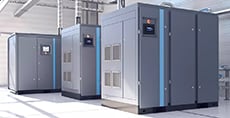Compressed Air is Not Free

Are you paying for 60 minutes of air but only getting 15?
Customer Challenge
A manufacturing facility in South Alabama was incurring major energy costs due to leaks in its compressed air lines, not its fluid process systems. These air leaks forced compressors to cycle on and off far more frequently than intended, driving up electricity usage and accelerating equipment wear. Without a structured compressed air leak detection program, the facility experienced decreased system efficiency, premature compressor failure, and increased exposure to costly rentals, replacements, and unplanned downtime.
Our Solution
Swagelok® Evaluation and Advisory specialists conducted a targeted audit of the facility’s compressed air system and uncovered numerous leaks in the air lines, many of which had been overlooked by routine plant maintenance. These leaks, while small and common in industrial settings, were silently driving up energy costs. Phase I of the audit focused on just a limited section of the plant’s compressed air lines, yet even in this small area, the projected annual savings totaled nearly $63,000 through reclaimed compressed air, improved energy efficiency, and reduced strain on maintenance, repair, and operations (MRO) resources. This indicates a much larger savings opportunity as additional areas of the plant are evaluated.
Impact on Energy ConsumptionFrequent compressor cycling is a red flag; not for process leaks, but for compressed air line leaks, which are often overlooked. Unlike visible fluid leaks, compressed air leaks are sneaky and silent, yet extremely costly. Many operators focus on process system integrity while missing the hidden drain on energy from leaking air lines. |
||
|
Swagelok’s fluid system professionals identified significant energy loss stemming directly from these compressed air leaks, revealing just how expensive this invisible issue can be. |
|
|
|
Energy Usage |
428,577 kWh |
|
|
Cost of Electricity |
$0.11 per kWh |
|
Annual Energy Cost |
$47,142 |
|
Leak Survey FindingsLeaks are expensive. Leverage Swagelok’s expertise to get to the source of the problem, every time. |
Our Fluid System Professionals Provide: |
Source and Cost of Leaks
|
Ancillary Expenses to Consider
The cost of renting just one air compressor could add almost $150,000 to your operating expenses.
Average Cost per Unit |
|
| Compressor Rental | $57 per hour |
| Installation & Maintenance* | $4 per hour |
| Diesel Fuel ($3.51/gal) | 3 gallons per hour |
Total Annual Cost** |
$148,782 |
*Oil and filter changes every 150-200 hours of operation
**2,080 working hours per year
To learn how Swagelok Evaluation and Advisory Services can benefit your facility, complete our Service Request Form or contact us directly to connect with an expert.
This data represents an actual report, however, total savings will vary based on number of leaks, size of leaks, orifice size, cost of electricity, operating hours and other factors. The data displayed here does not take into account maintenance costs as a part of total savings.



